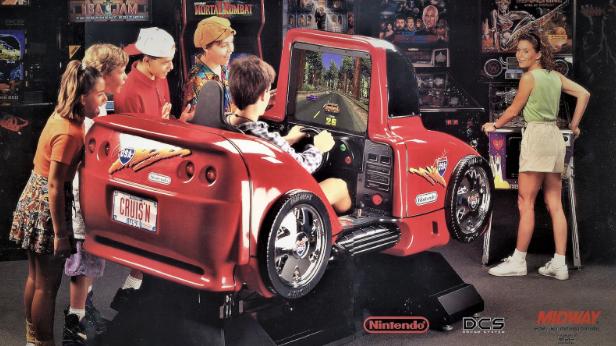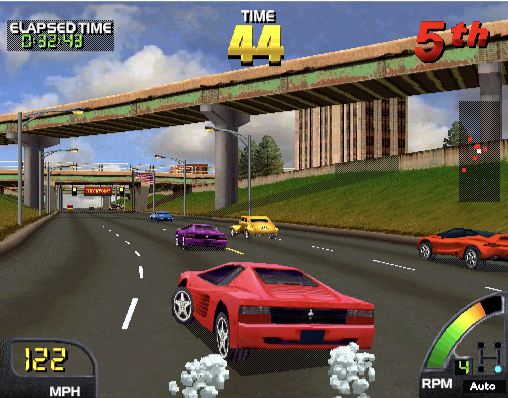By the end of 1994, racing games that would come to define the early days of the fifth console generation had already found a home in arcades. Namco’s Ridge Racer was first on the scene, demonstrating the advanced realism and immersion that polygonal graphics could add to a racing game. Sega stuck next with Daytona USA, a faithful recreation of the NASCAR experience. For Nintendo, a racing franchise that continues to the present began in late 1994 with an arcade game developed by famed game developer Eugene Jarvis and his company, TV Games Inc. The game would feature a cross-country race through recognizable locations in the continental U.S., realistic vehicles, and an arcade cabinet shaped like a car that players could sit in. The game was Cruis’n USA.
Eugene Jarvis built a name for himself as both a designer of pinball machines first for Atari and later for Williams in the 1970s. The rise of microprocessor-based video games heralded by Space Invaders caught Jarvis’ interest and he went on to design games including the side-scrolling blast-a-thon, Defender (1981), the dual-joystick robot battler, Robotron (1982), and the hyper-violent run-and-gun game Narc (1988). Jarvis would go on to serve as Cruis’n USA’s director, delivering a racing title for Nintendo that could compete with Sony and Sega’s best racing games.
A game of Cruis’n USA starts with players choosing one of seven vehicles based on real-world cars with legally distinct monikers. The 1963 “Muscle Car,” for example, is clearly a 1963 Chevrolet Corvette. What is clearly a Ford De Luxe is instead referred to as “La Bomba.” A Chevy Caprice police cruiser, a Jeep Wrangler, and a Hyundai HCD-II Epoch are also included.


Players can choose to cruise in manual or automatic transmission as they work their way from West to East across 14 races starting in Golden Gate Park in California, and ending in Washington D.C. Of all the games in the series, USA keeps things the most realistic with realistic locations and a distinct lack of power ups or speed boosts. That said, double tapping on the gas does allow you to pop a wheelie as flames shoot out of your exhaust. Sometimes realism must be sacrificed in the name of fun.
Cruis’n USA was advertised as the first release of the “Ultra 64” platform, the code name for the console that would eventually become known as the Nintendo 64. This turned out to be little more than enticing marketing for gaming rubes champing at the bit for a taste of Nintendo’s upcoming 64-bit console, however, as Cruis’n utilized the altogether different Midway V-Unit arcade board.
In the arcade, Cruis’n USA was available in three cabinet styles: An upright, a deluxe sit-down cabinet (with a racing-style seat) and a deluxe, full-motion simulator. The simulator version resembles a red Corvette on supports that rocks back and forth as players take a rough turn or evade traffic. In place of a windshield, this cabinet includes a honkin’ big CRT monitor to blast all the pulse-pounding action directly into your retinas. Turns out you shouldn’t sit too close to the TV unless you’re sitting in a race car-shaped arcade machine.
